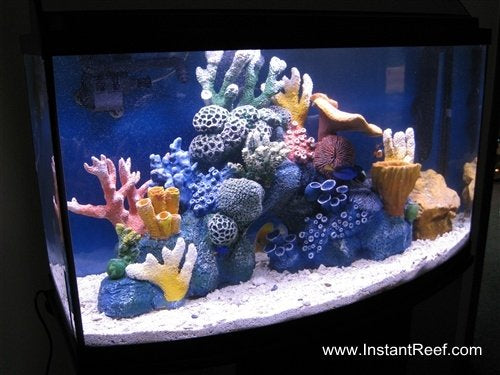How to set up a saltwater fish-only aquarium with artificial corals
How to set up a saltwater fish-only aquarium with artificial corals? Marine fish tank with live rock is very easy to set up and maintain. Without delicate corals, invertebrates, Saltwater Fish-Only aquariums do not require costly reef tank equipment like calcium reactor, RO/DI water, Intense lighting, marine water supplement. Plus you may enjoy all the salt water fish you like, no matter if they are "reef safe".

46 gallon bow-front tank.

Prepared 40 lbs. aquarium sand, crushed coral or gravel.

use a 5-gallon plastic bucket to rinse the sand

Rinse the sand thoroughly to remove all debris

Spread out the sand on the tank bottom.

Use a garden hose to fill up the tank.
Tip: use a saucer to protect the aquarium sand from flushing away.

We chose a canister filter for filtration.


Ceramic rings for bio-filtration.

Filter Foam.

Installed the aquarium canister filter, connected hoses.

We chose a hang-on type protein skimmer.
Tip: a protein skimmer can efficiently remove dissolved organic fish waste, leading better water quality.
Note: Protein skimmer does not work for freshwater fish aquariums.

Adjust the air-intake of protein skimmer to get maximum bubbling.

This protein skimmer is working fine.

An UV Sterillizer is also recommended for preventing excess algae growth.

install UV light bulb.

Hung the UV sterillizer behind the tank.

A heater is necessary for all tropical fish aquariums. It is recommend to use more than one heater to reducing the risk of malfunction.

A medium size Instant Reef artificial coral reef decoration was placed in the tank.

Make sure to use aquarium water conditioner for all water changes.


Measure Salt.

Slowly adding the salt to the aquarium.

Use an Hydrometer to measure both salinity and specific gravity.

Do not rush to add fish. Wait at least 24 hours for water chemistry becomes steady.

Slowly add one or two starter fish. Please understand "Aquarium Nitrogen Cycle" to avoid loss of fish.

Setting up an Artificial Coral Reef Aquarium has never been easier! Happy fish keeping!
